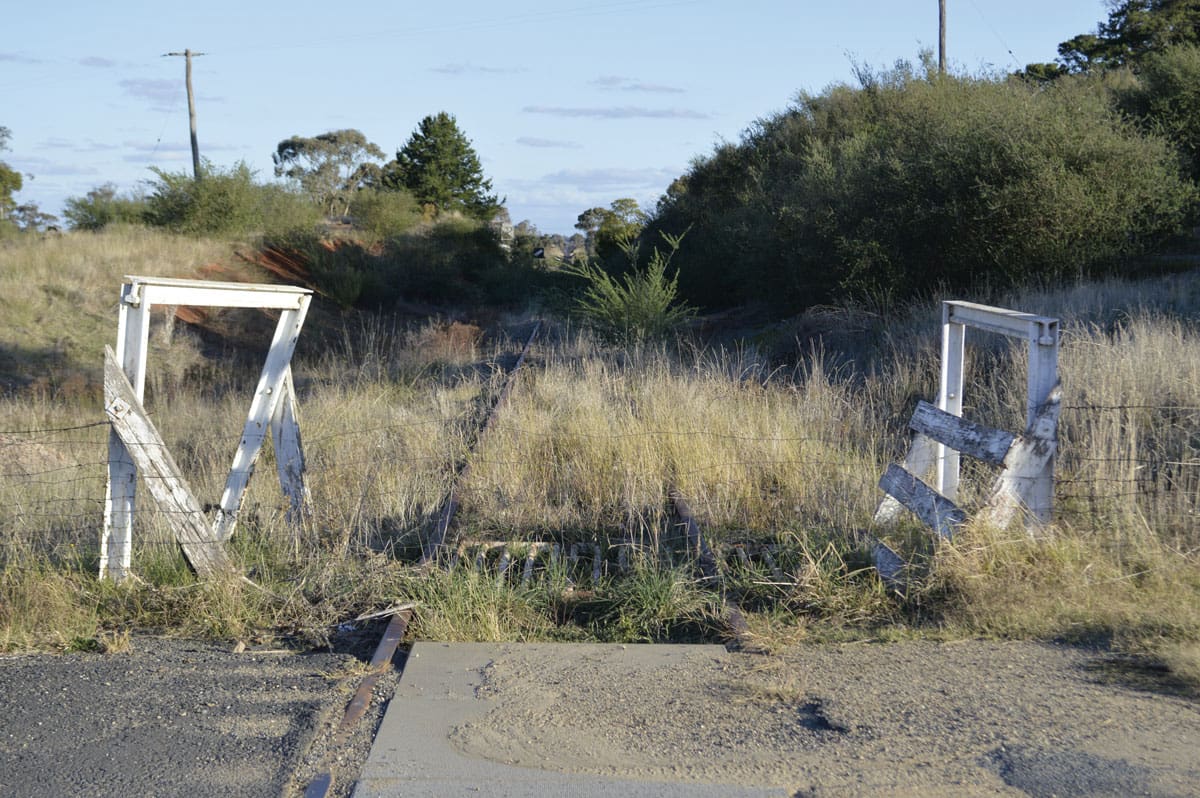Railway lines like the Demondrille-Blayney Line, pictured here at Kingsvale, will need a genuine commitment and a lot of work before they will ever re-open.
The New South Wales Government’s call for tenders to re-open the Cootamundra to Tumut and Yanco to Whitton railway lines is yet another example of the state government ‘holding a broom’ when it comes to infrastructure investment. The tender states that it “is seeking to restore, operate and maintain six Government-owned rail and land assets on a commercially sustainable basis without State funding,” and that it is “an example of the Government working with industry and using a commercial approach to develop a strong freight transport network in NSW.”
The tender is almost identical to that issued by the state government for the Demondrille-Blayney railway line re-opening, whereby the successful tenderer would have to rehabilitate, maintain and operate the line at tremendous cost without the involvement of the state government. It was, and perhaps in the case of this new tender, is, a tender designed to fail. To the state government’s surprise, one can wager, three parties indicated their interest in the Demondrille-Blayney line. The government subsequently found that the tenderers were ‘unsuitable’, believing that the tenderers would not be able to repair and operate the line without state government involvement.
By issuing calls for tenderers under such conditions, the NSW government is taking heed of an old piece of advice: “if you’re holding a broom, you’re working.” In essence, they are cultivating the appearance that they are actually working to re-open these mothballed or non-operational railway lines, despite there being no commitment of funds or resources to that end whatsoever.
That’s not to say there is not a genuine will to re-open the lines within the NSW Government. It may well be the case that the funds are just not available, and that more pressing infrastructure projects with more significant returns have been prioritised. One example is the North West Rail Link in Sydney, which will cost the government $8 billion to build a railway line from Rouse Hill to Chatswood, along with the ancillary infrastructure required. But very few companies in the private sector would be able to work to the conditions required by the state government tender, considering that any profitability would rely on other enterprises utilising the line.
The Lachlan Valley Transport Group, which includes Harden Shire Council, has called for a meeting with the NSW Minister for Roads, Maritime and Freight, Duncan Gay, to ask the Minister to consider the re-opening the Demondrille-Blayney railway line (Cowra Lines) in the wake of Infrastructure Australia’s (IA) ‘Australian Infrastructure Plan’ identifying congestion in metropolitan areas as resulting in “substantial economic and social costs”. Despite regional and local media claiming it could see a reopening of lines, the request is essentially a call for dialogue with the Minister on the topic. Let us not get ahead of ourselves.
Cowra Mayor Bill West said in a media release following the meeting, dated April 12, 2016, “The Councils see the strategic significance of the line re-routing from the Sydney train commuter network and providing a link directly into Port Kembla and Port Botany, a link that would be enhanced with the completion of the much-anticipated Maldon Dombarton link.” The Maldon Dombarton line originally began construction in 1983, but was cancelled before completion in 1988 by the Reiner Government. The line would have allowed Port Kembla-bound rail traffic to avoid having to traverse the busy Sydney metropolitan rail network. A tender with the same conditions as the Demondrille-Blayney line tender closed in April 2015 to finish construction and operate the line, with the same results. “No respondent was found to be capable of constructing, operating and maintaining the proposed railway line on a commercially sustainable basis, without NSW Government funding,” according to Transport for New South Wales. However, there may be some hope for mothballed and disused railway lines in southern NSW. IA’s ‘Infrastructure Priority List’, released in February 2016, lists a number of infrastructure projects across the country by priority. Listed as ‘near term’ is freight rail access to Port Kembla, with a business case currently being developed and assessed by IA. Although this is mainly focussing on the aforementioned Maldon Dombarton railway line, a business case for opening the old branch lines in our region could be included for consideration with the aim of facilitating freight rail access to Port Kembla.
In 2012/2013, Port Kembla exported 18,667,174 tonnes of goods to markets overseas. This number includes 2.6 million tonnes of grain. In light of the impending development of the Cunningar Grain Receival Site into an export site, reopening the Blayney-Demondrille line and other lines further west would enable greater access to export markets. It would also reduce the burden to state and local governments in repairing roads damaged by high productivity vehicles (HPVs) such as B-Doubles. However, the lines will never open if the government, at any level, intends to maintain a hands off approach. Development of improved infrastructure requires cooperation between the private sector and the various levels of government. Relying on private enterprise to front the high shot-term costs with a long-term prospect of profitability is not only unrealistic but impractical as well. Until the state government commits to funding and actions on its part, we will still be talking about reopening these lines in the decades to come. The government needs to start sweeping, instead of just holding the broom. Matthew Malone

